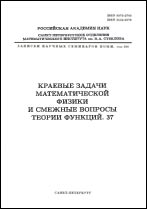|
|
Zapiski Nauchnykh Seminarov POMI, 2015, Volume 437, Pages 35–61
(Mi znsl6172)
|
 |
|
 |
This article is cited in 16 scientific papers (total in 16 papers)
Ortogonal pairs and mutually unbiased bases
A. Bondalabcd, I. Zhdanovskiyec
a Steklov Institute of Mathematics, Moscow, Russia
b Kavli Institute for the Physics and Mathematics of the Universe (WPI), The University of Tokyo, Kashiwa, Chiba 277-8583, Japan
c HSE Laboratory of Algebraic Geometry, Moscow, Russia
d The Institute of Fundamental Science, Moscow, Russia
e Moscow Institute of Physics and Technology
Abstract:
The goal of our article is a study of related mathematical and physical objects: orthogonal pairs in $\mathrm{sl}(n)$ and mutually unbiased bases in $\mathbb C^n$. An orthogonal pair in a simple Lie algebra is a pair of Cartan subalgebras that are orthogonal with respect to the Killing form. The description of orthogonal pairs in a given Lie algebra is an important step in the classification of orthogonal decompositions, i.e., decompositions of the Lie algebra into a direct sum of Cartan subalgebras pairwise orthogonal with respect to the Killing form. One of the important notions of quantum mechanics, quantum information theory, and quantum teleportation is the notion of mutually unbiased bases in the Hilbert space $\mathbb C^n$. Two orthonormal bases $\{e_i\}^n_{i=1}$, $\{f_j\}^n_{j=1}$ are mutually unbiased if and only if $|\langle e_i|f_j\rangle|^2=\frac1n$ for any $i,j=1,\dots,n$. The notions of mutually unbiased bases in $\mathbb C^n$ and orthogonal pairs in $\mathrm{sl}(n)$ are closely related. The problem of classification of orthogonal pairs in $\mathrm{sl}(n)$ and the closely related problem of classification of mutually unbiased bases in $\mathbb C^n$ are still open even for the case $n=6$. In this article, we give a sketch of our proof that there is a complex four-dimensional family of orthogonal pairs in $\mathrm{sl}(6)$. This proof requires a lot of algebraic geometry and representation theory. Further, we give an application of the result on the algebraic geometric family to the study of mutually unbiased bases. We show the existence of a real four-dimensional family of mutually unbiased bases in $\mathbb C^6$, thus solving a long-standing problem.
Key words and phrases:
orthogonal pairs, mutually unbiased bases (MUB), complex Hadamard matrices, generalized Hadamard matrices.
Received: 19.10.2015
Citation:
A. Bondal, I. Zhdanovskiy, “Ortogonal pairs and mutually unbiased bases”, Representation theory, dynamical systems, combinatorial and algoritmic methods. Part XXVI. Representation theory, dynamical systems, combinatorial methods, Zap. Nauchn. Sem. POMI, 437, POMI, St. Petersburg, 2015, 35–61; J. Math. Sci. (N. Y.), 216:1 (2016), 23–40
Linking options:
https://www.mathnet.ru/eng/znsl6172 https://www.mathnet.ru/eng/znsl/v437/p35
|

|




 Contact us:
Contact us: Terms of Use
Terms of Use
 Registration to the website
Registration to the website Logotypes
Logotypes








 Citation in format
Citation in format 
